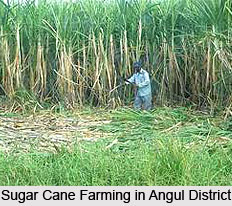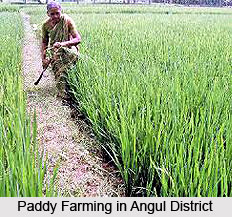 Angul District in Odisha is one of the economically prosperous districts. It is privileged both by agriculture and industry. The regional homogeneity and the optimal rainfall of Angul are conducive for the agricultural growth of the district. Agriculture shares a vital position in the economy of the district. It provides direct and indirect employment of about 70% of the total workforce of the district as per the 2001 census. About 2,16,403 hectares ;of land is cultivated, which covers an area of 32.7 % of the total geographical area.
Angul District in Odisha is one of the economically prosperous districts. It is privileged both by agriculture and industry. The regional homogeneity and the optimal rainfall of Angul are conducive for the agricultural growth of the district. Agriculture shares a vital position in the economy of the district. It provides direct and indirect employment of about 70% of the total workforce of the district as per the 2001 census. About 2,16,403 hectares ;of land is cultivated, which covers an area of 32.7 % of the total geographical area.
About 23% of the cultivated land is irrigated. Hence the distribution and quantity of rainfall have a vital bearing on the crop coverage and the crop yield. However the administrative unit of the district has taken several attempts to uplift the agricultural growth in Angul. The Deputy Director, Agriculture, Dhenkhal range with his field officers at Angul are providing agricultural extension services to the farmers. The field functionaries are modified to accentuate the crops production thereby supplementing the economy with highly productive crops.
The proper utilization of the technology and the scientific measures are also helpful for the development of agriculture, which contributes the major section of Angul`s economy. Training programs for the farmers, at the same time providing them with productive hybrid seeds and disseminating the new technology with balanced and integrated use of fertilizers, use of bio fertilizers and bio pesticides etc. induce the scientific method of agriculture, most of the cultivated area is brought under the system of double cropping, so that maximum yielding of crops supports the financial set up in Angul.
Paddy, Maize, Ragi, oilseeds, pulses, small millets and vegetables etc. are the principal crops of the Khariff seasons. The Rabi crops include paddy, wheat, maize, field pea, sunflower, garlic, Niger, potato, onion, tobacco and Sugarcane, coriander etc. Most of the crops supply the domestic requirements.
To enhance the agricultural coverage, irrigation, seeds, fertilizers and credit are considered to be the primary input. The medium irrigation projects- Derjang and Aunli etc supports the cultivation in Angul district to a large extent. Only the certified seeds are being sold in the sale centres of the agricultural department.
 Farmers are encouraged to produce high yielding seeds of the certified quality under the village program. Seeds are sold in the subsided market rate during the flood or draught. Under the seed replacement ratio mostly those hybrids seeds are grown in Gatisahaktipir and the adjoining areas.
Farmers are encouraged to produce high yielding seeds of the certified quality under the village program. Seeds are sold in the subsided market rate during the flood or draught. Under the seed replacement ratio mostly those hybrids seeds are grown in Gatisahaktipir and the adjoining areas.
Moreover the agricultural credit is supported by the finance from bank. Total agricultural credit ranges upto 3.66 crores and it is multiplied into 33.40 crores in 2001-02. "Pani Panchayat". Basically a society of farmers have been formed, who looks after the land management and the irrigation facility of the lands.
Though, Angul District is located at the agro-climatic zone of India, the region experiences vagaries of weather, including drought and flood, which hampers the economy to some extent. Two significant rivers Mahanadi and Brahmani, with their tributaries drained Angul. But since the rivers are solely rain fed, the agriculture is dependent on rain. Hence the proper utilization of the optimum rainfall and the profitable utilization of land have been emphasized for maintaining the stable growth in agriculture.
With the utilization of the modern technology the agriculture of Angul has attained prominence. Rashtriya Krushi Vima Yojna or National Agricultural Insurance Scheme was launched during the 9th Five Year Plan to provide insurance to the notified field crop. The Government subsidy is provided to the farmers in Angul now can purchase modern technical instruments to enhance the crop productivity. The agricultural tract of Angul is brought under the jurisdiction of Krishi Vighyan Kendra, a project under the Indian Council of Agriculture and Research, for testing and the transfer of agricultural technologies to the farmer communities. The government for the proper marketing of the surplus crops has set up 2 regulated markets. This induces the agricultural upliftment and brings the stability in the agriculture sector of Angul`s economy.
Horticulture and the orchard cultivation supply a major part of agricultural economy. Since much of the Horticulture products are exported, horticulture considered to be in the Cash crop section of economy. The highly nutritious and productive crops are in soaring demand nationwide. Angul is the fruit-bowl of Odisha and accounts to the major segment of the fruit export in Odisha.
The proper exploitation of the available lands, wasteland utilization and providing useful technology and subsidy to the farmers including their proper training etc. are the primary concerns of the government during the plan period to enhance the agricultural status of Angul`s economy. Moreover the non-profit organizations and the Self-Help co-operatives have come up to help the farmers and the under developed classes of Angul, economically. In the recent times agriculture is the principal section of the economy of Angul district.






